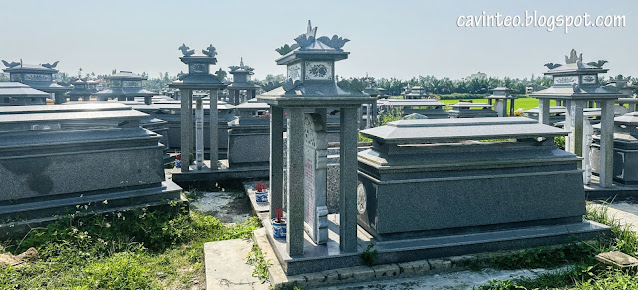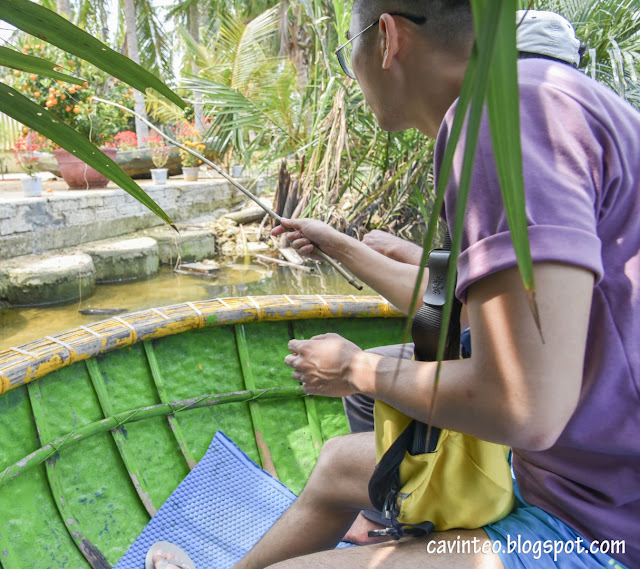Sub Postings
For the past two months, I posted a few posts pertaining to Hoi An Village Experience Cycling Day Tour as there were just too many photographs, and today, I shall stitch and condense everything into one post for ease of reference!
The morning started with the wait for the arrival of the day tour's tour guide. I was expecting a coach or a mini-passenger bus and right in front of us was a taxi! I went back to check my receipt; no, I didn't opt for a private tour. Nevertheless, we obediently followed the instructions...
We disembarked at this area about 2.2 kilometers away and met up with the rest of our tour mates. Our handsome tour guide also introduced himself; his name is Hoang (pronounced as Huang), 30 years of age, he spoke good English and aside from being helpful and funny, he peppered us with loads of interesting information throughout the day!
As you can determine from the subject title, this shall be a cycling tour and a command of bicycle riding shall be essential. Let us choose from the selection above; test for functionality, especially brakes, is a necessity.
And it's time to hit the streets; literally! Unlike busy Vietnamese cities like Hanoi and Ho Chi Minh City, the vehicular traffic wasn't as heavy. In addition, Hoang had also highlighted on safety and hand gestures that would allow us to have a smooth ride.
It's not long before we turned into lanes that would have been too narrow for cars although the risk would be for motorbikes. Don't overly worry as motorcyclists in Vietnam are usually quite safe as they don't go as fast as in Singapore and Malaysia.
Going deep into the greenery!
Good thing about cycling tour - it's not just the touristy landmark anymore. You get into the life of the locals, walk amongst the locals and have the opportunity to catch snippets of local activities.
Loving the ride with expansive padi fields flanking both sides of the path! Only thing that I didn't enjoy, the glaring sun and it was only about 9.00 am! p.s. two time slots for the tour; either 8.30am till 1pm or 2pm till 6.30pm.
Your typical farmhouse with roaming chickens! I was marvelled by the lack of fences to keep the chickens; aren't the farmers worried that the entire stock could be stolen or go missing?
For a moment, I thought this was a no-drone banner but after looking at it closer, it's more a promotional banner for the use of drones to assist in farming, like seed dispersing, watering, fertilizing.
Can't resist going into the pen and having a few pictures with them, despite the strong aroma of manure! Rest assured, I did seek permission and was careful with my steps.
Parked our bikes and went into the padi fields! Okay, I exaggerated a little as we were still on a dirt path but I guess it's helpful to ensure you don't wear too expensive shoes in case you slip and fall into the waterlogged fields.
Hoang shared with us nuggets of information about padi-planting; two harvests a year in Hoi An given the rainy season, warm water would be used to grow the seedlings and the land has to be raked, irrigated to about 5 centimeters before planting the seedling.
Growing rice is water intensive and the the fields have to be irrigated at least twice a day! One stalk of rice would have two branches and each branch gave only about 50 grains! Taking four months before you can harvest (when the stalks turn yellow), the farmers would then use sickle to cut the crop, dry under the sun and separate the grains from stalks by stomping on them.
Incredibly amount of work so we should always treasure the food put on our plates; don't waste, unless it's horrid tasting and for that, blame the one who cooks it. Anyway, so what happened to the stalks after you separate the grains? Known as straw, they have a myriad of uses; meal for water buffaloes, material for shelter, cooking fuel and even as fertilizer!
Photo of appreciation for the noble padi fields. As an ethnic Chinese, rice is a staple we can't live without from young and even though I am on a starch-restricted diet, I do indulge in rice occasionally, especially when it comes to curry dishes, chicken rice etc.
Let's hop onto our bicycles again!
It might not be so obvious but there were a lot of ducks on the sides of the stream. They were white and I have always wondered how they managed to stay so clean in the farms!
Remember I mentioned about irrigating the padi fields twice a day? The farmers would make use of the device as above, which served as a dam! Hence, the farmers are heavily dependent on nature and extreme weather can literally destroy all their hard work.
Coming to a vegetable farm and we were wondering why no one was tending to the plots of vegetables in front of us. Turned out the working hours for farmers are from 2am (you read that right) to 9am! That brick structure in the middle was actually to honor the farm god.
Hoang shared with us that aside from basil, this farm also harvests sweet potatoes and peanuts. Typically, sweet potatoes can be harvested after three months, first starting with the top (leaves and stalks) which can be sold as food (one big bundle cost only 5,000 dong), after which would be sweet potatoes. By then, leaves would be too old but could still be used for animal feed.
Well, if memory serves me well, the one on top would be peanut plants where the bottom would be the sweet potatoes leaf. Whatever the case, we can't wait to go off as it was so so hot!
This wasn't just a photograph of a typical motorbike; did you see the two dogs? In Vietnam, I was in awe of how dogs were being ferried on a motorbike. They would literally just stand on the footrest as their owner rides. Of course, this would be limited to scooters which have a wider footrest, and smaller dogs.
Enjoying the sights while cycling!
Every now and then, I would stop to take photographs while my tour mates were way ahead of me. I can only count my lucky stars that I still managed to catch up with them! See how far they were in the above photo!
We stopped in the middle of a crossroad right in the middle of a large padi field. Good for me as I was falling pretty far back although I pedalled as fast as I could.
Pointing to the cluster of stone structures a few hundred meters away, Hoang informed that the locals termed them as local hotel and the best kind as it would gaze upon the millions of stars when night falls.
Yes, the local hotel is, in reality, a cemetery!
More on local cemetery later.
Our first "activity" even though I had already learned so much from Hoang; Water Buffalo Riding and Traditional Farming, which included experiencing raking the padi field, planting the rice and feeding Say, the gentle water buffalo!
Tiring yet a sobering awakening for the hard work put in for the raw ingredients that go into our food; people just don't give enough credit to the farmers who work so diligently.
"Lucky" for me; there was a cemetery next to us where I made a quick exploration! This is the Cam Thanh Commune Cemetery, which looked small yet stretched for almost 200 meters by 100 meters.
Off we rode again but the landscape was different with taller trees and also cycling past ponds of water which we understood later to be shrimp farms!
Our next destination would be right after this stone bridge. The activity we shall be embarking was actually the reason why I choose the day tour in the first place as it's supposed to be popular among tourists.
Taking the Traditional Bamboo Basket Boat (aka Coconut Boat)! To be frank, I have high expectations for this activity, and although it was nice not having to do any physical work, and the fishing for crabs was interesting; it was quite boring for me. Maybe we should have taken on the spinning coconut boat option to make it more exciting!
Nevertheless, at least I had more time to pose and take millions of photographs. p.s. the above were the best among the millions.
Cycling again, to our final activity! With all the cycling, my stomach was already grumbling for lunch and yes, we would be going for a meal but it's more than just food served on our table and we just need to "work" using our mouths.
Here we are; Hoi An Village Experience Cooking School! To be honest, I am never keen to sign up for cooking classes when I am overseas. I figured it would be harder for me to secure the ingredients back in Singapore and I always prefer baking over cooking.
As part of our Hoi An Village Experience Cycling Day Tour, the cooking is only for just one dish, the easy Banh Xeo, which would be bearable for me. It's way more fun to see Alex cooking as it's rare to see him working the stove. You can read more via Making Fresh Rice Milk and Cooking Our Own Banh Xeo.
Those interested to embark on a half-day course to concentrate on cooking Vietnamese dishes can check out the Hoi An Village Experience website here.
Here's what we had for lunch; in a nutshell, what we had was satisfying, and nicely concluded our cycling day tour! Spring roll was crunchy and tasty, salad was good, and of course, my self-made banh xeo was perfect!
=====
Would I recommend this day? A 101% yes; it was informative, educational (strongly recommend for city folks) and the activities were not extremely strenuous! I am also glad to be assigned to Hoang, who was a fantastic guide and made us at ease with his witty jokes!
Website
Pricing of Tour
700,000 Dong / Person
Purchased from La Charm Hoi An Hotel & Spa




































































%20&%20Hoi%20An%20(The%20City%20of%20Lanterns)%20in%20Vietnam.JPG)
No comments:
Post a Comment